|
Music and Mime
Kochi, Kerala, India
by Sarah Shuckburgh
Rulers and religions have come
and gone, but traditional ays survive in the Indian state
of Kerala, says Sarah Shuckburgh.
 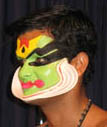 On stage, the young man is applying his makeup – mixing
green powder to make a paste fit for a hero, and adding
black eyeliner, zigzag brows, and wide, vermillion lips. He
sits effortlessly in the lotus position. On stage, the young man is applying his makeup – mixing
green powder to make a paste fit for a hero, and adding
black eyeliner, zigzag brows, and wide, vermillion lips. He
sits effortlessly in the lotus position.
Kathakali is the traditional theatre of Kerala, a ritualised
mime in which stories from the Mahabharata, the Ramayana and
the Bhagavata Purana are enacted by male actors who have
studied the ancient art since the age of eight. Performances
typically start at dusk and last until dawn, lit only by one
flickering oil lamp in the centre of the stage. This
one-hour show is for tourists, like me. When the beautiful
youth has completed his maquillage, a wrinkled old man
enters, and, to thuds from a drum, demonstrates a perplexing
series of eye movements, followed by wiggles of eyebrows,
mouth, head and hands.
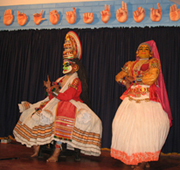 Two more musicians arrive, with gong and cymbals - and the
play begins. From behind a curtain, the green-faced youth
appears, now dressed in a knee-length crinoline and
yard-high gold crown. Bells adorn his shins, and he flicks
waist-length black tresses with long silver fingernails. As
a singer intones the narrative, our hero struts and adopts
strange postures, talons scissoring and pointing, knee-bells
jingling, bare feet stamping. I am riveted and bewildered. Two more musicians arrive, with gong and cymbals - and the
play begins. From behind a curtain, the green-faced youth
appears, now dressed in a knee-length crinoline and
yard-high gold crown. Bells adorn his shins, and he flicks
waist-length black tresses with long silver fingernails. As
a singer intones the narrative, our hero struts and adopts
strange postures, talons scissoring and pointing, knee-bells
jingling, bare feet stamping. I am riveted and bewildered.
In comes old Wrinkly, also in a mini-crinoline, and with
inauspicious yellow face-paint. He is the devil, disguised
as a loose woman and sent by the demon-god to tempt the
hero. A singer chants the dialogue as the demon drag-queen
tries all the tricks, but our hero isn’t fooled and
eventually chops off her head, ears, nose and breasts.
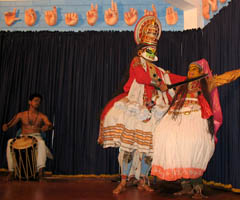
Darkness falls as I walk back through dimly lit streets to
Malabar House, a stately colonial bungalow turned chic
boutique hotel. I dine in the courtyard on coconut fish
curry and crispy appams, while musicians perform strange
Carnatic ragas on a seven-string vina made of resonating
gourds, and a barrel-shaped mridangam drum. Huge fruit bats
swoop in the hot night air, as I sip tulsi, a fragrant
infusion of local basil.
I am still thinking about the fate of loose women the next
day, when (after a breakfast of iddli, dhosa and masala chai)
I visit the Mattancherry palace, a series of gloomy rooms
with dark teak ceilings and stern portraits of dead
Maharajahs. The highlight is a sequence of intricately
detailed frescoes, painted in orange and red dyes made from
saffron and madder, and depicting scenes from the
Mahabharata and the Ramayana. I try in vain to spot the
scene from the Kathakali performance, where the hero-god
beheads the demon-woman.
My guide, Sabu, tells me that despite its educated, literate
population, and laws forbidding dowries and allowing
divorce, Kerala has India’s highest rates of wife-beating,
fatal ‘kitchen fires’ and other female molestations. Sabu’s
explanation for this paradox is that the statistics are
social constructions. Other less literate states rarely
report such crimes even though they may occur more
frequently - while educated Keralan newspaper readers have
come to expect sophisticated investigative journalism.
In Kerala, Hindu widows are permitted to remarry, but Sabu
explains that, as elsewhere in India, wives are
traditionally blamed for their husbands’ deaths. Suttee
(burning widows alive on their husband’s funeral pyres)
still occurs in rural Kerala, and, according to Sabu, many
widows resort to prostitution, or retreat to segregated
quarters. It is not only in the Kathakali theatre that the
heroes are men.
Kerala’s social policies seem to have plenty of loopholes.
Dowries are illegal, but bridegrooms’ families still expect
a ‘present’ from the brides’ parents. Bribery is against the
law, but payments of ‘permissible income’ continue, for
instance to a policeman if you are caught smoking in public.
Begging is banned except outside temples, but gangs of
beggars come from other regions. Kerala is officially a dry
state, but hotels and restaurants can buy licenses to serve
Indian wine and beer, and every village sells ‘spurious
liquor’ – illegal toddy.
 Sabu takes me to the old Jewish quarter, where Kochi’s
once-bustling oil and pepper exchanges are now silent,
closed with the advent of online dealing. In the narrow
streets, touts hassle tourists, urging them to buy carved
wood, clothes, spice boxes, lamps, masks and bric-a-brac. We
have lunch in a waterside restaurant - formerly a ginger
warehouse. As we nibble local cashew nuts, the chef warns:
“Chicken curry no good. Prawns not recommended.” I plump for
fish moily, speckled with whole cloves, cardamom seeds, chillis and blackened sticks of cinnamon, washed down with
fresh lime and ginger soda. Sabu takes me to the old Jewish quarter, where Kochi’s
once-bustling oil and pepper exchanges are now silent,
closed with the advent of online dealing. In the narrow
streets, touts hassle tourists, urging them to buy carved
wood, clothes, spice boxes, lamps, masks and bric-a-brac. We
have lunch in a waterside restaurant - formerly a ginger
warehouse. As we nibble local cashew nuts, the chef warns:
“Chicken curry no good. Prawns not recommended.” I plump for
fish moily, speckled with whole cloves, cardamom seeds, chillis and blackened sticks of cinnamon, washed down with
fresh lime and ginger soda.
As the afternoon cools, I explore the narrow lanes of Fort
Cochin, with its enchanting mix of Portuguese, Dutch and
British colonial architecture. Gabled cottages give a sleepy
village atmosphere. Scarlet bougainvillea frames
stable-doors, and rooks caw noisily as the sun drops behind
hundred-year-old trees. Every façade is festooned with
tangled electric cables.
Skirting a grassy parade ground where several informal games
of cricket are in progress, I pass the house where Vasco da
Gama lived, and the church where he was buried, which has,
over five centuries, welcomed Catholic, Dutch Reform,
Anglican and t hen Church of Southern India congregations.
‘Doubting Thomas’ is said to have brought Christianity to
Kerala as early as 54 AD. hen Church of Southern India congregations.
‘Doubting Thomas’ is said to have brought Christianity to
Kerala as early as 54 AD.
Down at the seafront, thousands have congregated: fathers
and sons are immaculate in crisp white lunghis, wives are
elegant in orange and red saris, little girls in colourful
ankle-length skirts. Passersby give me shy but welcoming
smiles, and the bravest ask me “Where coming from?” or
“Hello English?” Ice-cream vendors jangle bells to attract
custom for their lurid orange cornets. Ramshackle stalls
offer plastic windmills, flashing brooches, coconut milk, or
fish, fresh from the sea and fried to order. A young boy
kneels in the dust, producing smudged Spirograph designs on
tatty pieces of paper. Everyone is chattering in Malayalam.
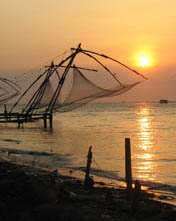 The stony shore is strewn with discarded coconut shells,
plastic straws, ice-cream tubs and rubbish. Boys gather to
watch a rat-snake slither across an avalanche of garbage, in
search of its favourite prey. Some families are paddling,
fully dressed, in the choppy, litter-strewn waves. The stony shore is strewn with discarded coconut shells,
plastic straws, ice-cream tubs and rubbish. Boys gather to
watch a rat-snake slither across an avalanche of garbage, in
search of its favourite prey. Some families are paddling,
fully dressed, in the choppy, litter-strewn waves.
At the famously picturesque Chinese fishing nets, I pause to
watch the crimson sun sink into the green-grey Arabian Sea.
Teams of fishermen are hoisting nets with teak and bamboo
levers, a method introduced by Kubla Khan’s traders in the
14th century. At this time, Cochin was already one of the
world’s most important harbours, used by Arab and Chinese
merchants.
As I walk back through gathering dusk to the Malabar Hotel,
I am caught up in a noisy throng of fami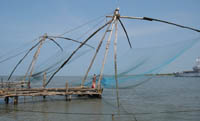 lies with wide-eyed
children and sleeping babes-in-arms, eagerly heading towards
the dimly-lit Kathakali theatre. I picture the actors,
applying yellow and green face-paint, donning crinolines,
wigs, bells and silver talons, wiggling their eyebrows and
stamping their feet to the drum-beat. An all-night
performance of Kerala’s traditional mime is about to begin. lies with wide-eyed
children and sleeping babes-in-arms, eagerly heading towards
the dimly-lit Kathakali theatre. I picture the actors,
applying yellow and green face-paint, donning crinolines,
wigs, bells and silver talons, wiggling their eyebrows and
stamping their feet to the drum-beat. An all-night
performance of Kerala’s traditional mime is about to begin.
Sarah travelled with Greaves Travel
www.greavesindia.com
First published by the Telegraph
©SarahShuckburgh |